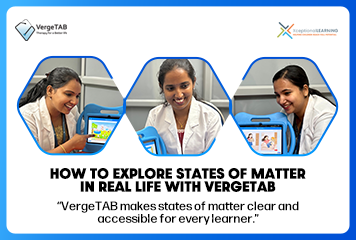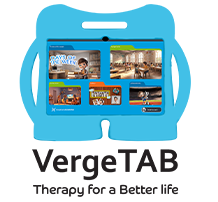How to Explore States of Matter in Real Life with VergeTAB
11 Nov 2025

Science isn’t just found in laboratories or textbooks—it’s connected to our daily lives. When children hold a toy, drink a glass of water, or watch a balloon float, they are actually interacting with the states of matter: solids, liquids, and gases.
For young learners, especially those in special education, understanding these concepts requires more than memorizing definitions. They need hands-on experiences, relatable stories, and interactive tools that make abstract science concrete.
This is where VergeTAB—a digital therapy and learning device powered by the XceptionalLEARNING platform—comes in. With interactive activities, step-by-step visuals, and gamified practice, VergeTAB transforms a tricky science lesson into an engaging journey. In this blog, we’ll explore solids, liquids, and gases in real-life scenarios, and see how VergeTAB bridges the gap between learning and living.
1. Solids — The World We Can Hold
Everyday Story
Imagine a child playing with building blocks. The blocks stay the same shape whether they’re stacked, lined up, or scattered. This simple play activity introduces the concept of solids—objects that have a fixed shape and volume.
Explanation in Simple Terms
Solids don’t change shape on their own. You can hold them, touch them, and move them, but unless you break or reshape them, they remain the same. Examples include toys, furniture, food items, and even your own body.
VergeTAB Experience
On VergeTAB, students can:
- Drag and drop objects into categories (solid vs. not solid).
- Use 3D visuals of ice cubes, chairs, and pencils to identify real-world solids.
- Play interactive sorting games where they distinguish between things that keep their shape and things that don’t.
Real-Life Connection
From brushing teeth with a toothbrush to eating a biscuit, solids dominate daily routines. Linking science to these tasks helps children integrate the concept.
Skills Developed
- Observation: Spotting solid objects in different environments.
- Categorization: Sorting items correctly.
- Fine motor control: Drag-and-drop tasks on VergeTAB encourage motor coordination.
Higher-Order Thinking
- Analysis: Why does a chair remain the same shape, but water doesn’t?
- Application: Predicting which objects will break or bend under force.
2. Liquids — The World That Flows
Everyday Story
At breakfast, a child pours milk into a glass. The milk takes the shape of the glass, unlike a biscuit that keeps its shape on the plate. This is a perfect example of a liquid.
Explanation in Simple Terms
Liquids don’t have a fixed shape—they flow and take the shape of the container.
But they do have a fixed volume: a glass of water will always remain the same amount, no matter what container it’s in.
VergeTAB Experience
On VergeTAB, learners can:
- Explore animated simulations of water being poured into different containers.
- Compare liquids like juice, oil, and milk through interactive visuals.
- Experiment virtually with “What happens if…?” scenarios: What if you freeze juice? What if you spill water?
Real-Life Connection
Whether drinking juice, washing hands, or watching rain fall, liquids are everywhere. Children quickly see how liquids shape everyday experiences.
Skills Developed
- Comparative thinking: Seeing how liquids differ from solids.
- Prediction: Guessing what will happen when a liquid is poured or frozen.
- Scientific curiosity: Observing cause-and-effect.
Higher-Order Thinking
- Evaluation: Which container is best for storing water—an open bowl or a closed bottle?
- Application: Designing a simple experiment at home (e.g., freezing different liquids).
3. Gases — The World We Breathe
Everyday Story
Picture a birthday party where balloons are being blown up. At first, the balloon is flat, but as air is blown in, it expands. That invisible air is a gas.
Explanation in Simple Terms
Gases have no fixed shape and no fixed volume. They spread out to fill any space. We can’t see them most of the time, but we can feel their effects—like when the wind blows or when we breathe.
VergeTAB Experience
With VergeTAB, children can:
- Watch simulations of balloons inflating and deflating.
- See animations of steam rising from hot water.
- Play “Guess the Gas” games, learning about oxygen, carbon dioxide, and everyday gases.
Real-Life Connection
From blowing bubbles to riding in a car, gases are part of daily experiences. Even something as ordinary as breathing becomes a science lesson when framed correctly.
Skills Developed
- Imaginative reasoning: Visualizing invisible gases.
- Connection-making: Linking gases to breathing and weather.
- Critical observation: Identifying evidence of gases in action (steam, balloons, bubbles).
Higher-Order Thinking
- Analysis: Why does a balloon burst when overfilled?
- Evaluation: What happens if there’s no oxygen?
- Application: Relating air pressure to weather changes.
4. Linking All Three — The Water Story
The best way to tie solids, liquids, and gases together is through water:
- As ice, it’s a solid.
- As liquid water, it’s a liquid.
- As steam, it’s a gas.
VergeTAB Activity
Learners can explore the water cycle interactively: freezing, melting, evaporating, and condensing. This cycle connects all three states in a way children can visualize and remember.
Skills Developed
- Sequencing: Understanding transformation steps.
- Problem-solving: Predicting what happens under heat or cold.
- Concept integration: Linking three separate concepts into one framework.
Higher-Order Thinking
- Synthesis: Combining knowledge of solids, liquids, and gases to explain weather.
- Evaluation: Judging why states change under temperature conditions.
Classroom and Home Applications
- In Schools: Teachers can guide group experiments with VergeTAB, like categorizing lunchbox items into solid/liquid.
- At Home: Parents can use everyday cooking (rice boiling, juice pouring) and then connect it with the interactive VergeTAB lesson.
This blended approach makes learning continuous and natural.
Interactive Challenges and Practice
VergeTAB doesn’t stop at explanations—it builds learning through practice. Some examples include:
- Challenge 1: Sort 20 everyday items into solids, liquids, or gases.
- Challenge 2: Predict what will happen if you freeze juice, heat butter, or blow into a balloon.
- Challenge 3: Interactive quiz—match each state of matter with a real-world example.
These challenges ensure learners don’t just memorize facts but apply them actively.
Reflection & Cognitive Skills
After activities, children are guided to reflect:
- What did I learn about solids, liquids, and gases?
- Where do I see them in my own life?
- How can I explain these concepts to someone else?
This reflection helps deepen cognitive skills like memory, communication, and critical thinking.
Cognitive Skills Developed
- Memory recall (facts and definitions).
- Critical thinking (evaluating examples).
- Problem-solving (predicting transformations).
- Communication (explaining concepts in their own words).
Higher-Order Thinking in Action
By the end, children don’t just recognize states of matter—they understand how and why they change, and can transfer this knowledge to new situations.
Cross-Curricular Links
VergeTAB lessons don’t stop at science—they connect across subjects:
- Mathematics → Measuring liquids in liters or milliliters.
- Geography → Understanding the water cycle—evaporation (gas), condensation (liquid), precipitation (solid/liquid).
- Art → Sculpting clay (solid) or mixing paints (liquid).
- Art + Science → Drawing steam rising to show air movement.
This makes learning integrated and practical, giving children multiple ways to connect with the same concept.
VergeTAB for Diverse Learners
Every child learns differently. VergeTAB’s digital activities, interactive quizzes, and step-by-step visuals ensure accessibility for:
- Children with speech delays who benefit from voice-activated prompts.
- Learners with attention difficulties, who thrive with gamified activities.
- Children with special needs, who rely on repetition, visuals, and tactile engagement.
This ensures no learner is left behind—each can experience success at their own pace.
Mini Case Study: Learning in Action
At a special education classroom, students struggled to grasp why air “takes up space.” Using VergeTAB, the teacher demonstrated inflating balloons. One student exclaimed, “The balloon is full, so air is real!”—a breakthrough moment only possible through interactive, visualized learning.
The Science Behind the Fun
Children discover that air is matter because it takes up space and can be observed through simple changes—like watching a balloon inflate.
STEM (Science, Technology, Engineering, and Mathematics) Connection
This activity ties directly to science and everyday learning, helping students see how classroom concepts connect with real-world understanding.
Quick Recap with a Visual Anchor
The balloon becomes a memory clue—whenever students see or use a balloon, they recall that “air is real.”
Future Explorations
Once children master solids, liquids, and gases, VergeTAB sparks curiosity for more:
- Plasma: The glowing matter in stars and lightning.
- Mixtures: Milkshakes, fog, and butter—everyday examples of multiple states.
- Changes of state: Freezing water into ice or boiling it into steam.
This keeps the journey open-ended, inviting learners to see science everywhere.
Conclusion
In conclusion, understanding solids, liquids, and gases isn’t just a school lesson—it’s a life skill. When children recognize the science in their food, play, weather, and breathing, the world becomes their classroom. VergeTAB brings this transformation alive with its interactive, multisensory, and personalized approach to learning. With every drag-and-drop game, animated simulation, or real-life connection, students gain not only knowledge but also skills that support independence, problem-solving, and critical thinking. Science stops being abstract and becomes a lived experience—one that children can see, touch, and apply every day.
Contact us to see how VergeTAB empowers children to overcome challenges and reach their fullest potential. This Affordable Therapy Device makes hands-on science accessible to every student. As an Interactive Learning Device for Children, VergeTAB combines fun with effective skill-building. Discover the Best Therapy Services With Tab that support growth, engagement, and confidence in learners of all abilities.
Related Reading
Exploring Science, Technology, Engineering, and Mathematics (STEM) Therapy with VergeTAB for Learning and Development
Discover how VergeTAB transforms STEM learning into an engaging, hands-on therapy experience—helping children strengthen problem-solving, creativity, and cognitive growth through interactive digital activities.


